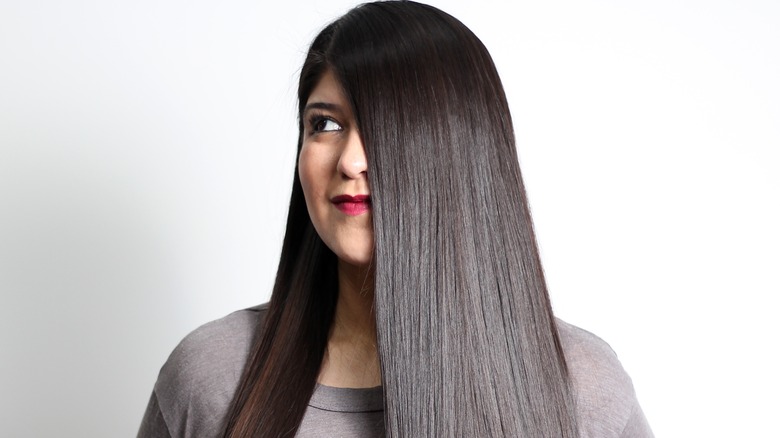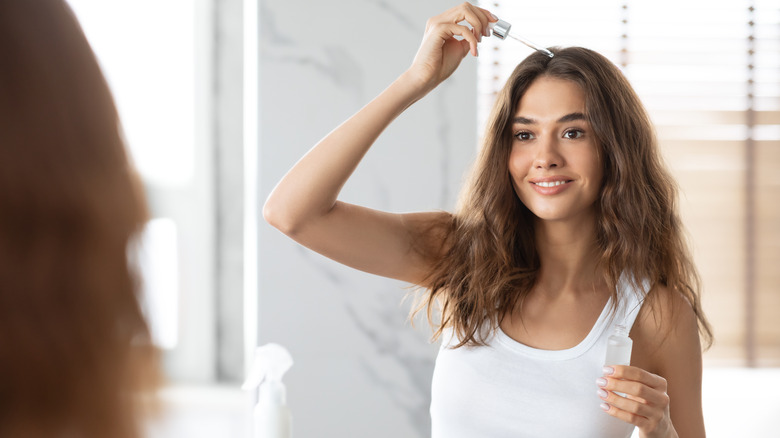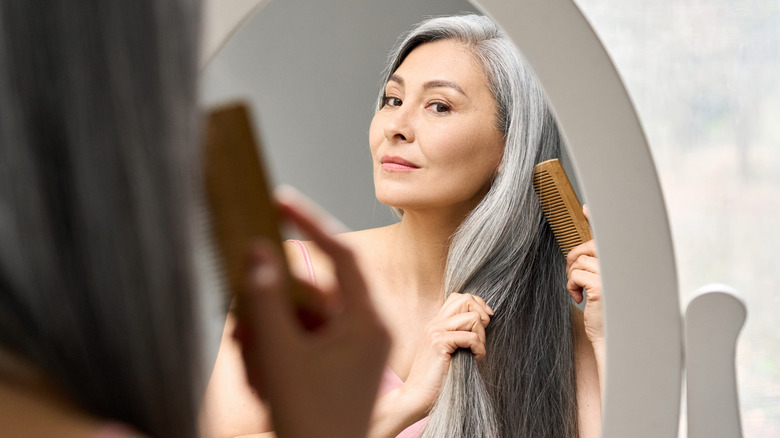The Slugging Trend Has Officially Come For Your Hair. Here's How To Do It
If you're a fan of Korean skincare or a connoisseur of TikTok beauty trends, skin slugging is probably not a new concept to you. As demonstrated by popular TikTok user @Moniquemrpapier, who has been credited with starting the trend, the practice entails coating your skin in petroleum jelly or a similar occlusive after you've finished your skincare routine and leaving it on overnight. The idea is to trap your moisturizers and serums and hold them on your skin for as long as possible to encourage maximum absorption.
It was probably only a matter of time before skin slugging branched out into the world of hair care. After all, chronic dryness is the number one cause of frizz, dullness, dandruff, and hair breakage, according to Healthline. But is this form of deep conditioning really new? Of course not. Hair oiling has been practiced around the world for 3,000 years, as reported by Outlook, especially in African and Asian cultures. If the practice is brand new to you, here's everything you need to know to decide whether or not to jump in head first.
How to slug your hair
Hair slugging is very similar to skin slugging as far as involving coating the hair in oil. It's actually even a bit simpler since it doesn't require as much preparation. Rather than going through your entire haircare routine before applying your oil, you just need dry hair that you plan to wash in the morning. You'll also need to choose an oil. For thick, coarse, or curly hair, you'll want to use a very thick oil like coconut or castor. If your hair is thin or fine, a lighter oil like grapeseed is a better choice to minimize greasiness or buildup. In fact, Dr. Isfahan Chambers-Harris tells Byrdie, "Any hair type can use grapeseed oil, but it's an excellent choice for thin or fine hair because it doesn't weigh the hair down."
Next, simply rub or brush the oil generously through your hair. This is where the only real question of technique comes in. The new trend of hair slugging only involves oiling your hair from the mid-lengths to the ends for a quick boost of shine from smoothing the cuticle. Traditional hair oiling includes massaging the oil into the scalp, which SkinKraft Laboratories reports may stimulate the hair follicles, and then working it through the rest of the hair for long-term nourishment. The choice is yours based on what your hair needs. Then, slip the hair into a sock and secure it with a soft hair band and leave it overnight.
What to expect when hair slugging
After your first night of hair slugging, you might wake up expecting a whole new head of hair. This might be a little bit of an overshot, but you will most likely see a noticeable difference in the form of more shine and less frizz. The longer you continue the practice, the more dramatic the result should become. If you choose to practice traditional hair oiling, you might even notice new growth over time and less scalp inflammation, according to Forbes.
If your hair is curly, kinky, coarse, thick, damaged, or dry, slugging is safe up to three times each week. If your hair is very fine or thin, however, be on the lookout for buildup. Start with one night per week. If your hair seems flatter, greasier, or duller than before you started slugging, reduce it to once every other week and be open to reducing down to once a month. Slugging too much for your hair type can weigh your hair down or even prevent it from absorbing your scalp's natural oils. Ironically, the result of this is drier hair than you started out with, as cautioned by TheHealthSite.com.


